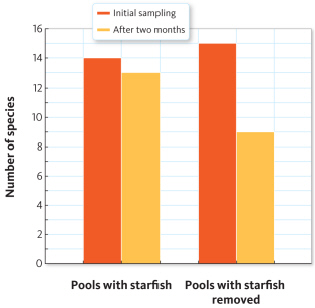Multiple Choice
Robert Paine was the first biologist to use the term keystone species in the 1960s. He was studying food webs in the rocky, intertidal pools in the Pacific Northwest. At one of his study sites, the dominant organisms in the tidal pools were mussels, barnacles, whelks, and a species of starfish known as Pisaster ochraceus . To examine the relationship between these species, Paine set up an experiment. In one area, he removed all the starfish from the tidal pools, and in an adjacent area, he left the tidal pools as he found them. Prior to removing the starfish, he sampled all the organisms in each pool. After two months, he repeated this sampling. A summary of his results is illustrated in the graph below.
As mussels and barnacles feed, how much of the energy that they take in from food is available to the whelks that eat them?
A) 10 percent
B) 90 percent
C) 1000 calories
D) 10,000 calories
Correct Answer:

Verified
Correct Answer:
Verified
Q2: A flock of flamingos wading and feeding
Q3: In a simple laboratory experiment, a researcher
Q4: Some species of bean bug, which are
Q5: In Chapter 3, you learned about the
Q6: A beetle that feeds on the leaves
Q8: A beetle that feeds on the leaves
Q9: Robert Paine was the first biologist to
Q10: The image below represents the termites, bacteria,
Q11: Robert Paine was the first biologist to
Q12: In spring, red-winged blackbird males return to